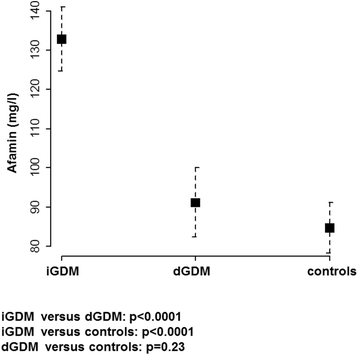Is Afamin a novel biomarker for gestational diabetes mellitus? A pilot study
- PMID: 29587878
- PMCID: PMC5870691
- DOI: 10.1186/s12958-018-0338-x
Is Afamin a novel biomarker for gestational diabetes mellitus? A pilot study
Abstract
Background: In search of potential early biomarkers for timely prediction of gestational diabetes mellitus (GDM), we focused on afamin, a vitamin E-binding protein in human plasma.. Afamin plays a role in anti-apoptotic cellular processes related to oxidative stress and is associated with insulin resistance and other features of metabolic syndrome. During uncomplicated pregnancy its serum concentrations increase linearly. The aim of this study was to investigate the suitability of afamin as early marker for predicting GDM.
Methods: In a first-trimester cohort from a prospective observational study of adverse pregnancy outcomes we secondarily analyzed afamin concentrations in 59 patients diagnosed with GDM and 51 controls. Additionally, afamin concentrations were cross-sectionally examined in a mid-trimester cohort of 105 women and compared with results from a simultaneously performed oral glucose tolerance test (OGTT). Subgroup analysis comparing patients treated with either insulin (iGDM) or dietary intervention (dGDM) was performed in both cohorts. Patients were recruited at the University Hospital Essen, Germany, between 2003 and 2016.
Results: Results were adjusted for body-mass-index (BMI) and gestational age. First and mid-trimester cohorts yielded significantly elevated afamin concentrations in patients with pathological OGTT compared to patients without GDM (first trimester cohort: mean, 113.4 mg/l; 95% CI, 106.4-120.5 mg/l and 87.2 mg/l; 95% CI, 79.7-94.7 mg/l; mid-trimester cohort: mean, 182.9 mg/l; 95% CI, 169.6-196.2 mg/l and 157.3 mg/l; 95% CI, 149.1-165.4 mg/l, respectively). In the first-trimester cohort, patients developing iGDM later in pregnancy presented with significantly higher afamin concentrations compared to patients developing dGDM and compared to patients without GDM. In the mid-trimester cohort, mean concentrations of afamin differed significantly between patients with dGDM compared to controls and between patients with iGDM and controls. Patients with iGDM showed only slightly higher afamin levels compared to patients with dGDM.
Conclusion: Afamin may serve as a new early biomarker for pathological glucose metabolism during pregnancy. Further research is needed to determine afamin's concentrations during pregnancy, its predictive value for early detection of pregnancies at high risk to develop GDM and its diagnostic role during the second trimester.
Keywords: Afamin; Gestational diabetes mellitus; Insulin resistance; Oral glucose tolerance test; Pregnancy.
Conflict of interest statement
Ethics approval and consent to participate
All women provided written informed consent. The study was approved by the local research ethics committee of the University Hospital Essen, Germany (number 125212-BO).
Consent for publication
not applicable
Competing interests
Dr. Dieplinger is owner and shareholder of Vitateq Biotechnology GmbH, a spin-off company of the Medical University of Innsbruck, holding several patents related to research described in this article. All other authors disclose no conflicts of interest.
Publisher’s Note
Springer Nature remains neutral with regard to jurisdictional claims in published maps and institutional affiliations.
Figures


References
-
- HAPO Study Cooperative Research Group. Metzger BE, Lowe LP, Dyer AR, Trimble ER, Chaovarindr U, Coustan DR, Hadden DR, McCance DR, Hod M, McIntyre HD, Oats JJ, Persson B, Rogers MS, Sacks DA. Hyperglycemia and adverse pregnancy outcomes. N Engl J Med. 2008;358(19):1991–2002. doi: 10.1056/NEJMoa0707943. - DOI - PubMed
-
- Waters TP, Dyer AR, Scholtens DM, Dooley SL, Herer E, Lowe LP, Oats JJ, Persson B, Sacks DA, Metzger BE, Catalano PM. HAPO cooperative study research group. Maternal and neonatal morbidity for women who would be added to the diagnosis of GDM using IADPSG criteria: a secondary analysis of the hyperglycemia and adverse pregnancy outcome study. Diabetes Care. 2016;39(12):2204–2210. doi: 10.2337/dc16-1194. - DOI - PMC - PubMed
MeSH terms
Substances
Grants and funding
LinkOut - more resources
Full Text Sources
Other Literature Sources
Miscellaneous

